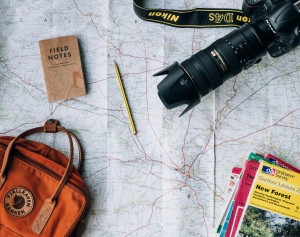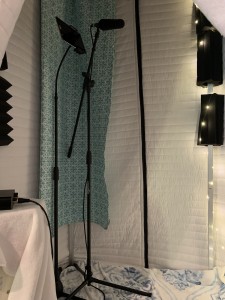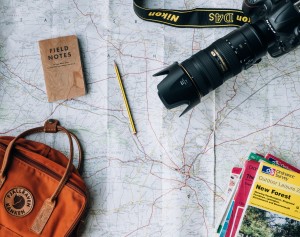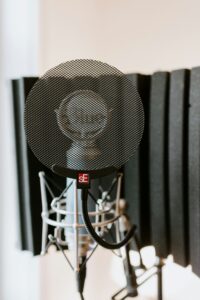This past year has been quite a doozy! Don’t you think we all deserve a nice vacation? I sure do. Fortunately, voice acting is surprisingly portable. So, whether you are planning that long-awaited trip or working out of town, there are many solutions to bringing your voice-over career with you wherever you go.
Approaching the question of how to get a good sound on the road follows the same basic principles you’ve dealt with when trying to get a good sound from your home studio, with one added element: portability.
Let’s break down the conundrum into 3 parts, emphasizing portability with each step: sound isolation, sound absorption, and recording equipment.
Sound isolation refers to keeping outside noise from coming into your recording. When you are traveling you have less control over where you are recording, but there are some things you can do to plan ahead.
If you are going to be staying in a hotel for example, you can request a top floor away from elevators and ice rooms. This will take away the possibility of noise from folks walking around above you and from equipment that will give you sound issues. Additionally, you can request a room that isn’t facing a busy street…or the pool. Choosing a hotel that is somewhat off the beaten path may help as well. As you know from setting up a home studio, the quieter you can get your space before you start to think about making it quiet, the better.
The same basic principles apply if you are renting a cabin in the woods, a house on the beach, or visiting your sister. Try your best to pick a spot that has access to a space that doesn’t face a busy street, loud machinery, and with as few neighbors as possible. If all else fails, consider using your car as a recording studio. Not the most comfortable option, but might be just what you need.
Once you’ve got as quiet of a space as possible, you should turn your attention to sound absorption. Sound absorption keeps your voice from bouncing around and gives it that nice “clean, lively, dead” sound that you hear in pro voice-overs. There are many solutions to this problem, some that you can buy right off the shelf and some a bit more DIY.
In terms of prefabricated options, you have to ask yourself how much space you can spare in whatever mode of transportation you are taking. There are a wide range of options: from portable booths that are the size of carry-on luggage to more robust options that you’ll most likely need a car to transport. Well respected Harlan Hogan has a free standing portable booth. New on the market is collapsible Tri-booth which weighs in at 40 lbs, but packs down into a duffel bag and can travel as checked luggage (check size and weight limits with your airline, obviously.) One of the most popular is Vocal Booth To Go’s mobile recording booth which packs down into a carry-on sized bag and weighs 17 lbs.
Alternately, you can get creative and build yourself a good old-fashioned blanket fort! Some of our first home booths are often blanket forts, so a lot of us have some pretty good experience in making these work. If you are in a hotel, vacation rental, or even your sister’s house, you can check in with them ahead of time and inquire about blanket, pillow, towel, and comforter options. You may even be able to request a few extras. Sometimes, even the pros end up in a blanket fort. You can watch Mike Delgaudio of Booth Junkie set up a blanket fort while on vacation for a last minute audition.
Once you know you’ll have a decent sounding space to record in, you have to think about recording equipment that is portable enough to be convenient, but durable enough to withstand travel, and high quality enough to sound professional.
First off, you’ll need a laptop or ipad with your DAW on it. I personally prefer lugging my laptop when I travel because I find it easier to edit on. However, if you are just doing an audition or two, you may be able to get away with just bringing an ipad. Remember, some DAWs like Twisted Wave for example, offer ipad apps or can be used virtually over the internet.
Speaking of the internet, it is always good to check in with a hotel, rental, (or your sister) about the availability of a high quality internet connection. And, if needed, know how to hot-spot yourself on your cell phone.

Next, turn your attention to your microphone and audio interface. You may want to travel with your setup just the way you have it at home. If you do, pack it very carefully and make sure you keep it with you as a carry on in the plane, or in your car. Most of us have large-diaphragm condenser microphones in our home studios and those are very delicate studio microphones and require some “handling with care.”
Personally, I travel with a shotgun microphone. They are a bit more durable and much more packable. The only drawback is that the pickup pattern on the shotgun is quite narrow, so you’ll have to make sure that you stay on-axis in front of the microphone, even while doing your very best acting.
If you don’t want to lug your audio interface with you, I recommend you check out some developing technology. Here is a tiny travel audio interface from CEntrance Polsen and here is one from Shure. I haven’t tried them myself, but if anyone has, let us know how it’s working for you!
Finally, you’ll have to consider whether you want to pack your home studio mic-stand or invest in a light desktop mic stand. The same goes for things like your music stand, your pop filter, and your long studio cables.
As it turns out, I’m writing this from my temporary escape from New York City right now! I have my collapsible audio-blanket fort set up in Miami. It’s a combination of things I’ve brought with me from home, things I’ve pieced together as my own little invention, and materials that were in the vacation rental. I’ve included a couple of pictures for your inspiration.

Check out our free PDF with pro-tips from real working voice-over actors here!
Want to learn more about voiceover? Signup for our introductory VO webinar.





